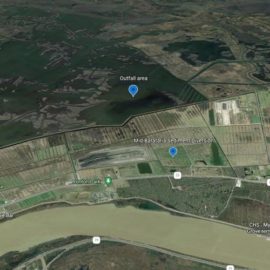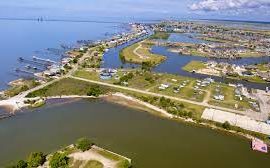
IMAGE FROM GOOGLE EARTH
A monumental moment as the EIS for the Barataria Diversion is released. One step closer.
Louisiana’s proposed $2 billion project to divert water and sediment from the Mississippi River into Barataria Basin as part of an unprecedented plan to fight coastal land loss moved a major step forward on Monday with the release by the Army Corps of Engineers of a final environmental impact statement. The study on the Mid-Barataria Sediment Diversion will form the basis of decisions to award federal and state permits for the project. Those permits could come as early as December, providing definitive approval for the project labeled “monumental” by state officials. It would be paid for with money from settlements related to the 2010 BP Deepwater Horizon oil spill.
nola.com
THe EIS was long ear update from prior submissions.
The year-long update of the environmental study confirmed that the project will provide significant future storm surge flooding reductions for New Orleans area west bank residents by creating nearly 21 square miles of new land through 2070. But it also reiterated that there will be significant damaging effects to commercial finfish, oyster and shrimp catches, and some additional flooding risk to communities just south of the diversion location on the west bank of the Mississippi in Plaquemines Parish. The study also repeated concerns that at least three of four family groups of bottlenose dolphins that call the Barataria Basin home are likely to become virtually extinct because the freshwater from the diversion will damage their health. But despite those problems, state officials still see the diversion as the most needed capstone of Louisiana’s 50-year coastal Master Plan, representing a significant reduction in the amount of wetlands expected to be sacrificed to subsidence and human-fueled sea level rise along this part of the state’s coastline through the end of the century. “This is a monumental moment for the state and the state’s coastal program,” said Chip Kline, chairman of the state Coastal Protection and Restoration Authority during an interview on Monday. “It has been told to us by members of the Biden administration that this is the largest coastal restoration project in the country, and the largest of its type anywhere in the world.” He said Monday’s release of the report put the state on the “two-yard line” in its efforts to move the project into construction at the beginning of 2023.

(Army Corps of Engineers)
The diversion is to mimic what the Mississippi did eons ago as it build the Louisiana delta.
The diversion would essentially mimic the processes that created southern Louisiana in the first place, sending as much as 7 million tons of sediment into the basin each year. Louisiana’s land-loss crisis is due in large part to the levees that keep the Mississippi River on its current path and protect the communities surrounding it from flooding. What is now Louisiana was built slowly over eons by sediment deposited by the shifting river, which no longer occurs because of the levees, resulting in the interior land sinking as water and air are released over time. At the same time, land-loss has been worsened by other man made factors, including the canals cut through the marsh by the oil-and-gas industry and sea-level rise exacerbated by climate change.
Adding fresh water and sediment is going to cause some damage to the wildlife. There are mitigating actions.
Included in the study is an updated summary of the state’s plans to mitigate some of the expected damages, at a cost of $378 million compared to the $300 million proposed a year ago as part of the preliminary environmental report. While posted on the Corps’ website on Monday, the 12,757-page main report and appendices become official when its publication is listed in the Federal Register on Friday, beginning a 30-day public comment period that will end Oct. 24. Officials in the Corps’ New Orleans district headquarters and its Vicksburg, Miss., division headquarters are expected to release an official “record of decision” document on Dec. 23 that will either approve or deny three major permits that the project needs: A permit required under an 1899 law governing dredging and filling in wetlands, Another under the federal Clean Water Act that also governs projects that affect wetlands and their natural resources, And approval of the project’s potential effects on existing federal projects, including the hurricane levees on the west bank and the navigation channel of the Mississippi River.

The BP oil spill money is being used for this ambitious project.
Federal and state officials acting as trustees for the natural resource damage restoration funds set aside for Louisiana after the 2010 BP oil spill also are using the final environmental assessment to confirm their decision to pay for completion of the state’s work on design and construction of the diversion, and the rules under which it will operate. The diversion is being designed to capture as much of the sediment carried by the river as possible. Sediment and freshwater will move through gates at mile marker 61 near Myrtle Grove into a 2-mile-long concrete channel that will end in an area of open water in the midst of wetlands in the east-central area of the Barataria Basin. The diversion is designed to discharge up to 75,000 cubic feet per second of sediment and water into the basin, equal to 7.5% of the river’s flow when it reaches a high-water 1 million cfs during spring Midwest flood months. When the river flow increases to 450,000 cubic feet per second or greater at Belle Chasse, usually in the late winter or early spring, the main gates would be opened, and a year-round flow through the channel of 5,000 cfs would be increased to 25,000 cfs. The amount of water in the channel would increase to the maximum 75,000 cfs, when the flow in the river reaches 1 million cfs. When the river drops again to 450,000 cfs, the gates would be closed and the flow would return to the background level. The background level is enough water to assure that sediment doesn’t clog the exit area of the diversion, and to maintain newly vegetated wetlands in the basin.

(Army Corps of Engineers)
The diversion will send 5-7 millions of sediment for building back the land.
The diversion would carry 5 million to 7 million tons of sediment a year into the basin, “which would have permanent, major, beneficial impacts on land building,” the report said, creating nearly 10 square miles of new land in the basin in its first 10 years, and 27 square miles over 50 years. The amount of land created during the first 50 years would be offset by wetland losses from subsidence and sea level rise elsewhere in the basin, but would still result in an increase of about 21 square miles in new land area. And because of the location where the new land is designed to occur, the increased wetlands will provide additional protection to communities to its north, largely behind the West Bank and Vicinity half of the New Orleans area levee system.
There are negative effects of the diversion and the fisheries were the most contentious.
There are negative effects from diverting the sediment into the basin, though. Part of that sediment would otherwise likely end up in the birdfoot delta at the mouth of the Mississippi River. The study concludes the area will see a 4.7-square-mile reduction in size by 2070, including in parts of the Delta National Wildlife Refuge and the state-owned Pass A Loutre Wildlife Management Area, though some of that might be offset through better management of existing flows through the area, or through beneficial use of material from maintenance dredging of the lower river. The diversion likely will result in water levels increasing within the Barataria Basin by as much as 1.1 foot, with the higher levels closer to the diversion. That could mean “negligible to minor” increases in levee overtopping of non-federal hurricane levees in Plaquemines Parish south of the diversion beginning about 20 years after the diversion begins operation, in part because of sea level rise.

Army Corps of Engineers
The updated mitigation section answers many of the questions.
The state’s updated mitigation plan includes a variety of measures for those communities. For Grand Bayou, the plan calls for raising roads and other access points, raising docks and piers, improvements to sewage systems, and some voluntary buyouts. The community’s requests for assistance in building floating gardens, community boardwalks and projects to close nearby canals and restore elevated ridges also have become part of the plan, said Bren Haase, executive director of the coastal authority. The Myrtle Grove community will see construction of a new community bulkhead, efforts to raise docks and piers, and the option of voluntary buyouts. The Happy Jack, Lake Hermitage, Suzie Bayou and Woodpark communities will see similar projects funded by the state. The environmental report confirmed several of the complaints raised over the past few years by commercial fishers concerned the freshwater addition to the basin will hurt their oyster, shrimp and finfish catches. “Overall, the proposed project would likely have major, adverse impacts on the Barataria Basin population of eastern oysters (predominantly from salinity changes and sedimentation) and brown shrimp (predominantly from changes in salinity and precluded larval recruitment),” the study said. Spotted sea trout, known commonly as speckled trout, and southern flounder also would be adversely impacted.

(Army Corps of Engineers)
There are other benefits that the diversion is pushing.
However, the report also said some beneficial impacts are expected for other commercial fisheries, including white shrimp, blue crab, bay anchovy, Gulf menhaden, red drum, largemouth bass and a variety of freshwater fishes. Haase said the state has held repeated meetings with representatives of the fishing community, and the state Department of Wildlife & Fisheries is also participating in planning as one of the BP trustees. The state increased the share of mitigation money reserved for fisheries from $33 million last year to $54 million in the final environmental statement, and expanded eligibility for assistance to include shoreside facilities that buy catches from fishers, and the docks the fishers own. The updated plans also added crab and finfish to the list of species eligible for mitigation money. For blue crab, the efforts will include funds for gear improvements and marketing support. For brown shrimp, vessel and facility improvements, including refrigeration equipment and possible funds to help pay for larger boats will be funded, as well as marketing support. For oyster growers, Haase said a variety of efforts will build on ongoing fund that the coastal authority has made available to the Department of Wildlife & Fisheries to expand alternative elevated oyster culture projects. Other proposals that will be funded include new public seed grounds, efforts to improve existing public and private oyster grounds, new broodstock reefs, and marketing support. All of the fishery efforts will also be targeted by a new program announced by the coastal authority last week that will assist the Louisiana Community and Technical College System in creating a training and certification program to provide alternative jobs supporting construction of the diversion and of the dozens of other coastal restoration programs already under way or planned by the authority in future years.

(Army Corps of Engineers)
There is also an economic side to the diversion.
According to the authority, the diversion is expected to create 12,000 direct and indirect jobs in southeast Louisiana, mostly in Plaquemines, St. Bernard, Jefferson and Orleans parishes, in addition to $1 billion in increased sales and as much as $650 million in additional household earnings.
They will be looking to receiving comments on the diversion and I urge all so participate.



